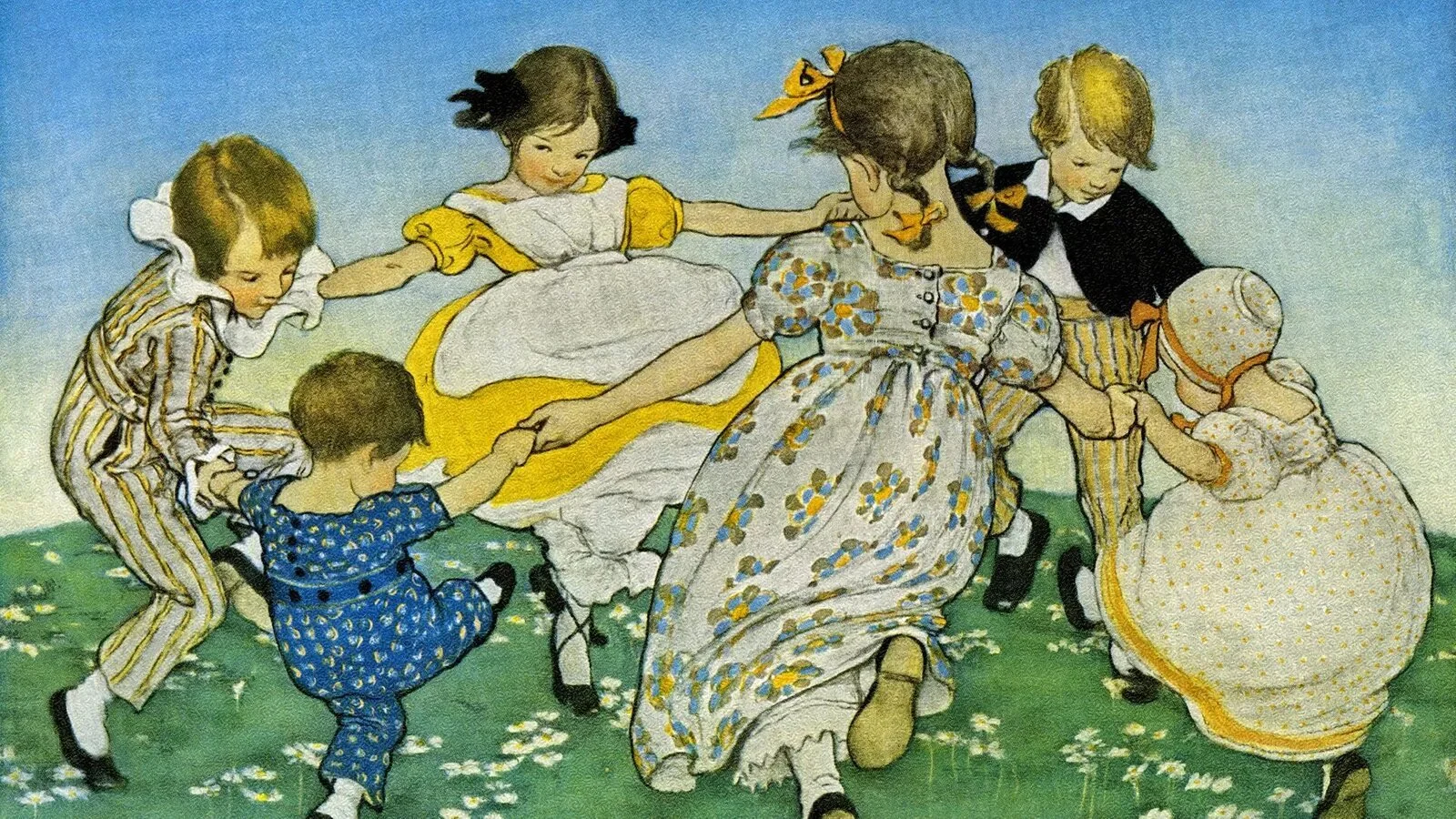8 Dark Nursery Rhyme Meanings
"The best nursery rhymes are simple, repetitive, and full of rhythm. They are also often humorous or absurd, which makes them even more appealing to children."
—Elizabeth Silvey
I was pretending my 2-year-old was a baby as I rocked back and forth and I sang “Rock-a-bye baby.” As her giggles subsided, I started questioning what the heck these lyrics meant. I knew that nursery rhymes like Ring Around The Rosey had some dark undertones to it but why am I gleefully singing about this baby plummeting from the top of a tree?
So, my interest was piqued and, naturally, I went hunting for answers. So here are 8 dark nursery rhyme meanings, an incomplete explanation on why we still sing them, and an exploration on why they exist at all.
Dark Nursery Rhymes
Why Do We Sing Nursery Rhymes Anyways?
The most effective means of transferring and retaining information across generations used to be storytelling and music, with nursery rhymes standing as the poster child for this practice. In an era predating Google searches and TikTok videos, knowledge was relayed through oral tradition, nursery rhymes served as a simple an effective medium for this.
Furthermore, nursery rhymes incorporate elements of folklore, historical events, or traditional customs, conveying cultural lessons and values prevalent during their origins, often reflecting the context of the times they emerged. Whether it's the cautionary tales about refraining from dissenting against the church or monarchy, or the wisdom to evacuate a leaning house, these rhymes encapsulate a treasure trove of insights, as we'll explore shortly.
Why Are Some Nursery Rhymes So Dark?
Behind the charming melodies and playful cadences of nursery rhymes, however, there exists a hidden layer of darkness. These seemingly innocent verses meant to entertain and educate young children, often carry with them a sinister history and meaning that is far from child's play.
But why do some nursery rhymes take on such dark undertones? The answer lies in the complex layers of human history, where these rhymes serve as snapshots of societal norms, fears, and even political commentary.
In a time when children's literature was often intertwined with adult themes, these rhymes provided a platform for subtle dissent and social critique. Through coded language and metaphor, they allowed people to convey messages that might have otherwise been censored or punished. Some nursery rhymes also evolved from centuries-old folk traditions and ballads, preserving fragments of folklore and superstitions that were prevalent in times long past
Now, let’s explore some of the darkest nursery rhymes to start second-guessing ourselves..
10 Examples Of Dark Nursery Rhymes
1. Ring Around The Rosie
"Ring a Ring o' Roses," often referred to as "Ring around the Rosie" in some regions, is a seemingly innocent nursery rhyme with a hidden dark history. The darkness behind this nursery rhyme is rooted in its connection to the Great Plague of London in 1665.
"Ring a ring o' roses" refers to the circular rash, resembling red roses, that appeared on the skin of plague victims. "A pocketful of posies" represents the practice of carrying flowers or herbs to ward off the foul odors believed to transmit the disease. "A-tishoo, a-tishoo" mimics the sound of sneezing, a common symptom of the plague. Finally, "we all fall down" is a chilling reference to the high mortality rate during the outbreak, where many succumbed to the deadly disease. This nursery rhyme serves as a somber reminder of the devastating impact of the bubonic plague
Ring a Ring o’ Roses
Ring a ring o' roses,
A pocketful of posies,
A-tishoo, a-tishoo,
We all fall down.
2. Mary, Mary, Quite Contrary
"Mary, Mary, Quite Contrary" is believed to be a reflection of the tumultuous reign of Queen Mary I of England, commonly known as Bloody Mary due to her brutal persecution of Protestants during her rule. The seemingly innocent lyrics mask a sinister reference to the religious strife and cruelty that marked her reign.
"Mary, Mary, quite contrary" suggests a contradictory and harsh disposition, mirroring the queen's reputation for religious intolerance. "Silver bells and cockle shells" are thought to refer to instruments of torture used during her reign, while "pretty maids all in a row" are though to be a reference to the execution of Protestant women.
Mary, Mary, Quite Contrary
Mary, Mary, quite contrary,
How does your garden grow?
With silver bells and cockle shells
And pretty maids all in a row.
3. Rock-a-Bye-Baby
The lyrics of "Rock-a-Bye-Baby," first written down in 1765, tell a tale of a baby in peril, cradled in a treetop that sways precariously in the wind. No one knows the true origin of this, however, it’s thought to symbolize the fragility of life, particularly that of an infant, and underscores the idea that even the most delicate and cherished things can be easily disrupted by external forces.
Rock-a-Bye Baby
Rock-a-bye baby, in the treetop,
When the wind blows, the cradle will rock,
When the bough breaks, the cradle will fall,
And down will come baby, cradle and all.
4. Jack & Jill
While "Jack and Jill" may seem like a simple tale of childhood mishaps, there are darker interpretations and historical theories associated with this rhyme. One popular theory suggests that "Jack and Jill" may have roots in historical events, specifically the beheading of King Louis XVI and Queen Marie Antoinette during the French Revolution. In this interpretation, "Jack" represents Louis XVI, and "Jill" symbolizes Marie Antoinette. The fall down the hill may be a metaphorical reference to their fall from power and subsequent execution.
Jack and Jill
Jack and Jill went up the hill
To fetch a pail of water.
Jack fell down and broke his crown,
And Jill came tumbling after.
5. Ladybird, Ladybird
The origins of “Ladybird, Ladybird” are believed to be connected to a time when houses were often constructed of timber and thatch, and the risk of fires was significant. When a fire erupted in a home, it could spread rapidly and become a devastating force, leaving those inside with little time to escape. The rhyme reflects the fear and desperation of a ladybird as it searches for safety amidst the flames.
There are a few theories about who Ann represents. One theory is that she represents the Virgin Mary, who is often depicted as holding a child in her arms. Another theory is that she represents the hope for the future, even in the midst of tragedy.
Ladybird, Ladybird
Ladybird, ladybird, fly away home,
Your house is on fire, your children all gone;
All except one, and that's little Ann,
For she crept under the frying pan.
6. Goosey Goosey Gander
"Goosey Goosey Gander" dates back to the 18th century and reveals a glimpse into the political and religious tensions of the time, as well as the consequences faced by those who did not conform to prevailing beliefs.
The lyrics describe a man who, upon discovering an old man or priest in a "bed" or "closet," tosses him down the stairs for refusing to say his prayers. This reflects the religious conflicts that plagued England during the 17th century. This period saw the struggle between Catholics and Protestants, with religious tensions often leading to persecution and violence. The rhyme's mention of refusing to say prayers suggests a resistance to religious conformity, and the punishment meted out underscores the harsh consequences faced by those who held differing beliefs.
The rhyme also hints at a broader theme of secrecy and hidden truths. The old man or priest's presence in the "bed" or "closet" may symbolize hidden beliefs or dissenting opinions that were kept concealed for fear of reprisal. The act of throwing him "downstairs" may represent society's rejection of non-conformity and the harsh consequences faced by those who dared to challenge the status quo.
Goosery Goosey Gander
Goosey Goosey Gander,
Whither shall I wander?
Upstairs and downstairs
And in my lady's chamber.
There I met an old man
Who wouldn't say his prayers,
I took him by the left leg
And threw him down the stairs.
7. Three Blind Mice
"Three Blind Mice" is believed to have originated during a time when England was under the rule of Queen Mary I, also known as "Bloody Mary" due to her violent persecution of Protestants. This nursery rhyme is thought to be a satirical take on her reign and the brutality that ensued.
The three blind mice in the rhyme represent three Protestant noblemen who were accused of plotting against Queen Mary. The "cut off their tails with a carving knife" line refers to the punishment they received, which was to be burned at the stake. The severity of their punishment highlights the cruel and unforgiving nature of the times.
Three Blind Mice
Three blind mice, three blind mice,
See how they run, see how they run,
They all ran after the farmer's wife,
Who cut off their tails with a carving knife,
Did you ever see such a thing in your life,
As three blind mice?
8. Pop Goes The Weasel
The origins and deeper meaning of "Pop Goes the Weasel" may reveal a grim reality of poverty and hardship in 19th-century London. The rhyme's lyrics tell the story of someone spending all their money, pawning their coat for cash, and ultimately ending up in dire straits. The phrase "pop goes the weasel" likely refers to the act of pawning a winter coat for money, which was a common occurrence among the impoverished population of London during that era.
Another theory is that the rhyme is about a machine used in the silk-weaving industry. The machine was called a "weasel," and it made a popping sound when it was finished measuring out the yarn. Thus, the rhyme could be seen as a celebration of the silk weaving industry or a warning about the dangers of working in that industry.
The rhyme could also be interpreted as a metaphor for life. The "pop" could represent the uncertainty of life, and the "weasel" could represent the things that we cannot control. The rhyme could be warning us that life is unpredictable and that we should be prepared for anything.
Pop Goes the Weasel
Half a pound of tuppenny rice,
Half a pound of treacle.
That's the way the money goes,
Pop goes the weasel.
Takeaway
Intriguing and enigmatic, dark nursery rhymes embody a fascinating blend of cultural preservation, historical commentary, and the timeless art of storytelling. These seemingly innocent verses, designed to educate and entertain young minds, conceal hidden histories and meanings that reflect the complexities of human existence. As essential tools for transmitting cultural values and knowledge across generations, dark nursery rhymes offer glimpses into the past while serving as potent vessels of social critique and dissent. They remind us that even within the simplest melodies, profound narratives can be found, shedding light on the enduring power of dark nursery rhymes to captivate, educate, and provoke thought.
Related:



